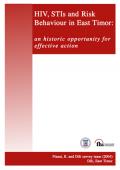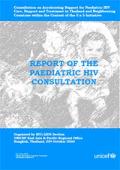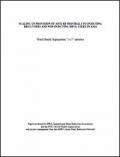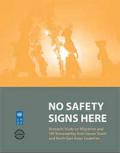What's New
Displaying results 4651 - 4660 of 4914

Resource | Publications,
At the time the national AIDS strategy was developed in 2002, no hard data were available to guide programme choices and help prioritise strategies. With the support of USAID, the Ministry of Health and Family Health International (FHI) collaborated with local NGOs and others on a quantative survey of HIV, other sexually transmitted infections (STIs) and risk behaviour. The survey was conducted in late 2003 in the capital city, Dili, among female sex workers (FSW), men who have sex with men (MSM), taxi drivers and male military personnel.

Resource | Publications,
The HIV/AIDS epidemic is still at a low level in the countries of Central Asia, but this situation presents a dual challenge: first, to call attention to the projected epidemic so that policy-makers at the national level understand what lies ahead, given international evidence on the growth of HIV infection; and second, to plan, in the context of extremely limited resources, a rational response to HIV/AIDS throughout the sub region. In Central Asia, as in the rest of ECA, the epidemic is rather significantly under-measured, but it is clear to all that HIV incidence is increasing, following epidemics of intravenous drug use (IDU) and sexually transmitted illnesses (STI) throughout these countries.
The Country Profiles summarize information available from Governments and partner organizations such as the UN agencies, USAID, and the Soros Foundation/OSI. It covers the following aspects: epidemiology; strategic and regulatory frameworks; surveillance; preventive, diagnostic, and treatment activities; non-governmental (NGO) and partner activities; and funding resources available.

Resource | Publications,
In 2004 India has as many HIV-infected people as any country in the world. And scientists tell us that an effective vaccine against AIDS is unlikely for at least another decade. Yet there is hope that the devastation of the AIDS epidemic can be slowed and even reversed in India.
The report analyzes three alternative plans for using and financing antiretroviral therapy (ART) in India. These alternative plans, or “scenarios,” are a minimally interventionist plan to strengthen the private sector’s ability to manage ART, a moderately interventionist plan to provide free ART to HIV-positive pregnant women and, if they are also infected, to their spouses and children, and a more generous plan to finance ART for the poorest 40 percent of all Indians with HIV infection.

Resource | Publications,
Since the discovery of the first HIV+ person in Viet Nam in December 1990, the HIV/AIDS epidemic has spread rapidly across the country. If unchecked, the epidemic could threaten not only the health infrastructure, but also the prospects for positive social and economic development of the country.
This report documents the work of FHI/IMPACT from 1998 to 2003, including the process and activities undertaken in both HIV/AIDS prevention and care and in capacity building efforts. It relates to the major achievements, challenges, and lessons learned, and the future direction of FHI-supported HIV/AIDS work in Viet Nam in the years to come. As the report reflects on lessons learned through the implementation of FHI supported projects in Viet Nam, an essential lesson draws to the forefront; the importance of partnerships with local authorities.
Working closely with community authorities, advocating to gain government support, involvement, ownership, and participation has had a significant impact on the success of projects.

Resource | Publications,
In 2001 the Thai Ministry of Public Health (MOPH) launched an antiretroviral therapy (ART) programme. A decentralized approach was adopted and treatment was initially provided to 1500 people living with HIV/AIDS (PLHA) in 112 government hospitals. Previously, health care for PLHA had been provided from specialist centres. By February 2004, 23,000 PLHA were being treated in 860 hospitals.
In 2003 the Ministry undertook to provide 50,000 people with ART by 2005 and it is intended that 20,000 more will receive ART through a social insurance scheme. This amounts to close to complete coverage and exceeds the WHO "3 by 5" target.
In parallel with these efforts, patient groups and nongovernmental organizations (NGOs) have been working to provide PLHA with enough knowledge to make informed decisions on treatment and to play a central role as partners in the provision of care.

Resource | Publications,
This publication summarizes existing evidence on the use of antiretroviral drugs for preventing mother-to child transmission of HIV and makes recommendations on the choice of regimens in the context of expanding access to antiretroviral treatment. It is part of a series of modules comprising guidelines on care, treatment and support for HIV-infected women and their children in resource-constrained settings being developed by WHO and its partners.
It is part of a series of modules comprising guidelines on care, treatment and support for HIV-infected women and their children in resource-constrained settings being developed by WHO and its partners.
The recommendations complement revised guidelines for antiretroviral treatment that have been issued in support of the 3 by 5 Initiative. The target of treating 3 million people in developing countries with antiretroviral therapy by the end of 2005 is a necessary, achievable target on the way to the ultimate goal of universal access to antiretroviral treatment for everyone who requires it.

Resource | Publications,
On October 20, 2004, 29 representatives from three countries and more than a dozen international and supranational organizations and hospitals attended the Consultation on Accelerating Support for Paediatric HIV Care, Support and Treatment in Thailand and Neighboring Countries within the Context of the 3 x 5 Initiative.
The meeting was intended to update those working on issues concerning Pediatric HIV/AIDS in the region on progress being made by their colleagues. It also aimed to strengthen communication and cooperation among those working on PMTCT and pediatric HIV/AIDS-related issues in the region through sharing country experiences and technical updates from global experts. Reporting on progress toward reaching the 3 x 5 goals, including increasing access to pediatric antiretroviral treatment, was also a cornerstone of the meeting’s agenda.

Resource | Publications,
Process models offer opportunities to explore the effectiveness of different program and policy alternatives by varying input behaviors and model parameters to reflect programmatic/policy effects.
Traditional theoretical HIV models set modeling parameters a priority and a small change in model parameters often gives widely varying results for the same behavioral inputs. The Asian Epidemic Model (AEM) has been designed to reflect the primary groups and transmission modes driving HIV transmission in Asia. The user adjusts AEM modeling parameters until HIV prevalence outputs from the model agree with observed epidemiological trends.
The AEM is a semi-empirical model, which has worked well in Asian settings. It provides a useful tool for policy and program analysis in Asian countries.

Resource | Publications,
This report was prepared to support WHO efforts to introduce and scale up anti-retroviral therapy (ARV) according to the “WHO 3x5” initiative which is designed to provide three million people with ARV by the year 2005. The International Harm Reduction Association (IHRA) together with regional harm reduction networks was asked to recommend strategies for scaling up ARV to injecting drug users (IDU) and to identify the potential role of the harm reduction networks.
This report gives a regional and country specific overview of the current situation with regards to the provision of services including ARV to IDU/DU in Asia. It provides an analysis of the political environment that impedes or facilitates the provision of ARV to IDU, and offers some recommendations for scaling up ARV and identifies possible models of care.

Resource | Publications,
In recent decades, countries in the Asia-Pacific region have experienced an increase in the mobility - that is, internal and international migration - of men and women in the region. This phenomenon has been accompanied by the relentless spread of the HIV/AIDS epidemic, which affects all countries, including smaller or somewhat isolated countries such as Mongolia and the Democratic People's Republic of Korea.
The UNDP Regional HIV and Development Programme in partnership with Asia Pacific Migration Network (APMRN) commissioned this study in seven countries of the region - Bangladesh, China, Democratic People's Republic of Korea (DPRK), India, Mongolia, Republic of Korea, and Sri Lanka - to undertake a systematic review of the existing knowledge on migration routes and processes, trafficking routes, the conditions under which men and women move, their living and working conditions, and their vulnerabilities to HIV/AIDS. The study also reviewed the legal and policy environments, and identified and analysed the gaps in the existing knowledge and areas for possible action.





